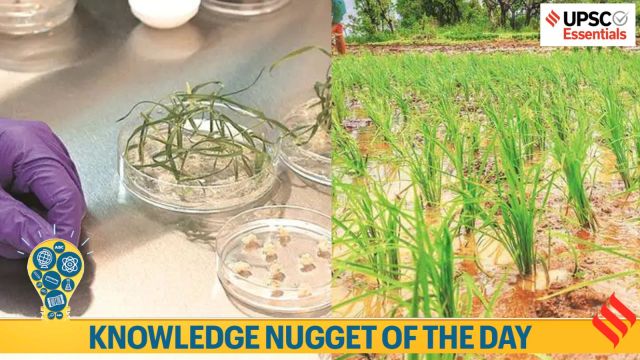
Why in the news?
The Indian Council of Agricultural Research (ICAR) said it has developed the world’s first genome edited (GE) rice varieties with superior yields, drought and salinity tolerance, and high nitrogen-use efficiency traits. Union Minister of Agriculture and Farmers’ Welfare Shivraj Singh Chouhan released the two rice varieties at the ICAR’s NASC Complex on Sunday (May 4).
Story continues below this ad
Key Takeaways :
1. Two affiliate institutions of ICAR— the Hyderabad-based Indian Institute of Rice Research (IIRR) and the Indian Agricultural Research Institute (IARI) at New Delhi — have bred improved GE mutants of the popular Samba Mahsuri (BPT-5204) and Cottondora Sannalu (MTU-1010) varieties using CRISPR-Cas SDN-1 (Site-Directed Nucleases-1) technologies.
2. These two new GE rice varieties, which are climate-resilient, conserve water, and boost yields, have been named ‘Kamala’ and ‘Pusa DST Rice 1’. They have better stress tolerance and climate adaptability without any compromises with their existing strengths.
3. DRR DHAN 100 (KAMALA): Developed by the ICAR-IIRR, this variety promises significantly higher yields, improved drought tolerance, and early maturity compared to its parent variety, Samba Mahsuri (BPT 5204). According to the ICAR, DRR Dhan 100 (Kamala) has been developed using genome editing technology targeting the Cytokinin Oxidase 2 (CKX2) gene (also known as Gn1a), to increase grain numbers per panicle.
• “Using the Site Directed Nuclease 1 (SDN1) genome editing approach, ICAR-IIRR scientists introduced precise mutations without incorporating any foreign DNA.” the Council said in a statement. The ICAR release pointed out that DRR Dhan 100 (Kamala) retains the grain and cooking quality that makes Samba Mahsuri a consumer favourite.
Story continues below this ad
• The Kamala variety has been recommended for cultivation across major rice-growing states, including Andhra Pradesh, Telangana, Karnataka, Tamil Nadu, Puducherry, Kerala (Zone VII), Chhattisgarh, Maharashtra, Madhya Pradesh (Zone V), Odisha, Jharkhand, Bihar, Uttar Pradesh, and West Bengal (Zone III).
4. PUSA DST RICE 1: This new GE variety has been developed over the widely cultivated fine-grain variety called MTU1010 by ICAR-IARI. It has been developed through SDN1 genome-editing, this new variety targets the Drought and Salt Tolerance (DST) gene to improve the plant’s resilience to harsh soil and climate conditions.
• The new variety is relevant for farmers of saline and alkaline soils, where traditional varieties underperform. This variety of rice has been recommended for cultivation across key rice-growing states, including Andhra Pradesh, Telangana, Karnataka, Tamil Nadu, Puducherry, Kerala (Zone VII), Chhattisgarh, Maharashtra, Madhya Pradesh (Zone V), Odisha, Jharkhand, Bihar, Uttar Pradesh, and West Bengal (Zone III).
5. In the case of 2 new genome edited (GE) rice varieties, scientists at IIRR have used the CRISPR-Cas12 protein for editing the ‘cytokinin oxidase 2’ gene (also called Gn1a) in Samba Mahsuri rice, in order to the increase the number of grains produced from each panicle (plant earhead) of this variety.
Story continues below this ad
Why Rice?
1. Rice, like other crops, is exposed to various biotic and abiotic stresses during its life cycle. Several diseases such as bacterial leaf blight and blast, and insect pests like the brown plant hopper, cause significant damage that result in devastating yield reductions. The crop losses from some of these biotic stresses can be as high as 50% and even reach 90% in epidemic conditions.
2. In addition, rice accounts for more than half of the fresh water used in agriculture. Water availability for agriculture in general is becoming a significant constraint now, due to ever-increasing domestic, urban and industrial consumption requirements. The situation will become more complex with decreased arable land availability as well, not to speak of the impact of climate change on crop productivity.
3. Successful development of rice lines, incorporating important biotic and abiotic stress resistant traits, can provide solutions for minimising yield losses that affect consumers (from reduced availability) and producers (from lower incomes) alike.
What is Gene Editing Technology ?
1. Gene editing, also known as genome editing, is a technique that allows scientists to ‘cut’ DNA strands and edit genes. The technology enables a simple but remarkably efficient way to ‘edit’ the genetic codes of organisms, thus opening up the possibility of ‘correcting’ genetic information to cure diseases, prevent physical deformities, or even produce cosmetic enhancements.
Story continues below this ad
 How the technique works
How the technique works
2. Advanced research has allowed scientists to develop highly effective clustered regularly interspaced palindromic repeat (CRISPR) -associated proteins-based systems. This system allows for targeted intervention at the genome sequence.
3. Its mechanism is often compared to the ‘cut-copy-paste’, or ‘find-replace’ functionalities in common computer programmes. A bad stretch in the DNA sequence, which is the cause of disease or disorder, is located, cut, and removed — and then replaced with a ‘correct’ sequence. The tools used to achieve this are not mechanical, but biochemical — specific protein and RNA molecules.
How is Gene Editing different from Gene Modification?
1. GE is different from genetic modification or GM. The latter involves introduction of genes from unrelated species into host plants. These could, for example, be genes from Bacillus thuringiensis, a soil bacterium, that code for the production of proteins toxic to various insect pests in cotton.
2. GE, on the other hand, entails mere “editing” of genes naturally present in the host plant, leading to mutation or changes in their DNA sequence. No foreign genes or DNA are incorporated.
Story continues below this ad
BEYOND THE NUGGET: CRISPR-Cas9 and Site-Directed Nuclease Approaches
1. In the last decade, targeted genome editing using “CRISPR/Cas9” has captivated the attention of the research community. The applications of this technology — an acronym for “clustered regularly interspaced short palindromic repeats/CRISPR-associated protein 9” — have gained significant traction in various fields of science, including agriculture.
2. CRISPR-Cas uses ‘Cas’ enzymes, or proteins that act like molecular “scissors”, to cut and modify the DNA sequence of a native gene at its targeted location. Such editing is intended to bring forth desirable alterations in that gene’s expression and function.
3. CRISPR/Cas9 was originally identified and adapted from a naturally-occurring immunity mechanism in bacteria, which is employed against invading viruses. The bacteria basically capture snippets of DNA from the viruses and use them to create CRISPR arrays. These DNA segments allow the bacteria to “remember” the viruses. In the event of the viruses attacking, the bacteria produce RNA (messenger that carries genetic information from the DNA) from the CRISPR arrays. The bacteria then uses Cas9 enzyme, which acts as a pair of “molecular scissors”, to cut the DNA apart and disabling the virus.
4. The same system has been engineered by researchers to produce RNA complementary to a specific target DNA sequence in the genome of an organism. This “guide” RNA binds itself only to that target sequence and no other regions of the genome. The Cas9 enzyme will, in turn, follow the guide RNA and cut the two strands of DNA at the targeted location. At this stage, the cell knows that the DNA is damaged and tries to repair it. The researchers can now use the natural DNA repair machinery to introduce changes, including by adding or deleting genetic material.
Story continues below this ad
5. Such genome editing using CRISPR/Cas9 is possible through three different approaches: Site-Directed Nuclease (SDN) 1, 2 and 3.
📍SDN1 produces a double-stranded break in the genome of a plant and modifies an existing trait without undertaking insertion of any foreign DNA or even editing at the site of interest.
📍SDN2 modifies the trait of interest by producing a double-stranded break and, while that is being repaired by the cell, editing a small sequence at the target site.
📍SDN3 uses site-specific insertion of a large, foreign DNA fragment to introduce a new trait of interest.
Story continues below this ad
Post Read Question
What is Cas9 protein that is often mentioned in news? (UPSC CSE 2019)
(a) A molecular scissors used in targeted gene editing
(b) A biosensor used in the accurate detection of pathogens in patients
(c) A gene that makes plants pest-resistant
(d) A herbicidal substance synthesized in genetically modified crops
(Sources: For the first time, 2 new genome-edited rice varieties: Why is this such a major breakthrough for ICAR and India’s agriculture?, ICAR marks a first, develops two genome-edited varieties of rice, Agricultural biotechnology: Gene Editing versus Gene Modification.)
Subscribe to our UPSC newsletter. Stay updated with the latest UPSC articles by joining our Telegram channel – Indian Express UPSC Hub, and follow us on Instagram and X.
Story continues below this ad
🚨 Click Here to read the UPSC Essentials magazine for April 2025. Share your views and suggestions in the comment box or at Manas Srivastava 🚨



 How the technique works
How the technique works






























